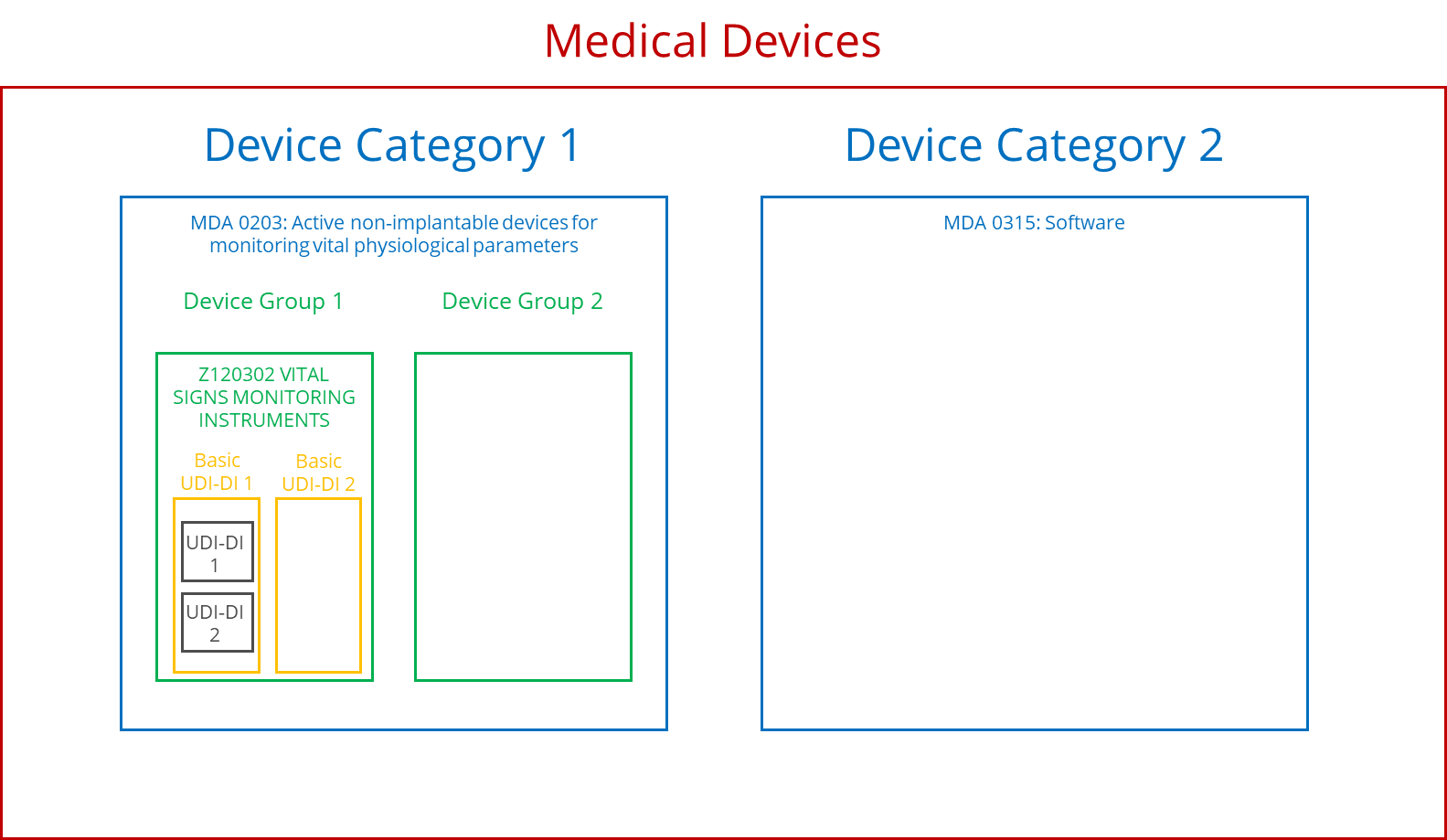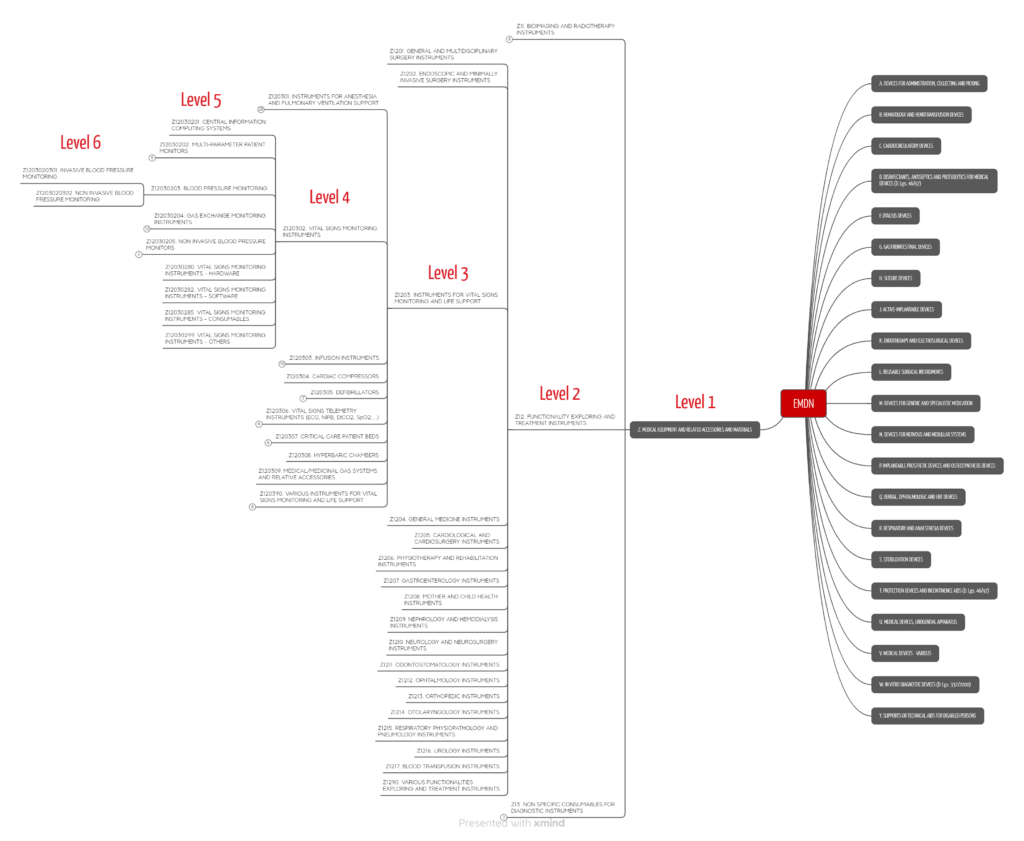The MDR and IVDR use the terms device category and generic device group without fully defining them. ISO 13485:2016 introduces the medical device family. Finally, the MDCG uses the term device range. The definitions of these terms determine the allocation of UDIs and the sampling of product files during certification.
Therefore, it is important for manufacturers, authorities, and notified bodies to have a common understanding of device categories, generic device groups, medical device families, and device ranges. This avoids unnecessary disputes during audits, when evaluating the technical documentation, and when deciding whether manufacturers may assign the same Basic UDI-DI or UDI-DI to two devices.
1. Definitions: What are device groups and device categories?
The EU Medical Device Regulation MDR does define the term generic device group. But it does not define what a device category is. The guidance document MDCG 2019-13 gives more clarity.

a) Generic device group
MDR definition
The MDR defines a generic device group as follows:
“A “generic device group” describes a group of devices with the same or similar intended uses or with technological similarities that can be classified even without considering specific features;”
Source: MDR Article 2(7)
Determination of the MDCG: Generic device group corresponds to the 4th level of the EMDN
This definition would certainly lead to consistent discussion about the correct classification. Therefore, it is welcome that the Medical Device Coordination Group MDCG wants the generic device group to be understood.
“as the 4th level of the European Nomenclature on Medical Devices (EMDN) (i.e. combination of one letter plus 6 digits) [in respect of the MDR], and in respect of the IVDR as the 3rd level of the EMDN (i.e. combination of one letter plus 4 digits respectively) in combination with the most appropriate IVP code.”
MDCG 2019-13
For example, blood pressure monitors would not form a generic device group (see Fig. 2) since they are already at the fifth level. They are part of the generic device group “Vital Signs Monitoring Instruments.”

The CND/EMDN system includes 1681 codes on the fourth level – ergo 1681 generic device groups.
b) Medical device family according to ISO 13485: More granular than the “generic device group”
Not to be confused with the generic device group is the medical device family according to ISO 13485:2016:
“group of medical devices manufactured by or for the same organization and having the same basic
design and performance characteristics related to safety, intended use and function”
Source: DIN EN ISO 13485:2016-08 (3.12)
The term medical device family is narrower than the generic device groups according to MDR, as it only includes devices with the same intended use and, above all, the same design and performance characteristics. For example, two consumer-market forearm blood pressure monitors that differ in system architecture would fall into the same generic device group but not the same medical device family.
ISO 13485 allows manufacturers to create common technical documentation for devices in a medical device family. The MDR and MDCG allow this for devices with the same Basic UDI-DI but not necessarily for devices from the same generic device group.
c) Device category: Corresponds to the MDA/MDN codes
The MDR does not define the term device category. According to the MDCG, this refers to the “codes of the corresponding device types” in accordance with the EU Implementing Regulation (EU) 2017/2185:
“category of devices should be understood as the relevant MDA/MDN codes (MDR) or IVR codes (IVDR) according to Regulation (EU) 2017/2185 on the codes for the designation of notified bodies.”
Source: EU 2017/2185
This regulation distinguishes 71 codes for the devices regulated by the MDR and 79 codes for IVD medical devices. The categories divide the medical devices into larger classes than the device groups (see also Fig. 1).
d) Device range: The umbrella term
The MDCG introduces another term with device range:
“Device range is to be understood as all “device categories“ for Class IIa and Class B devices and all “generic device groups” for Class IIb and Class C devices covered in a certificate.“
Source: MCDG 2019-13
Thus, device range is the umbrella term that refers to a device category (class IIa) and a generic device group (class IIb), depending on the class of the devices.
2. Relevance: Why device groups and device categories are important
a) Sampling of medical devices in audits and evaluations of technical documentation
Sampling depends on class
The division of devices into device groups and device categories is relevant to the sampling, meaning the selection of samples for QM audits and the evaluation of the technical documentation:
- For less critical devices of class IIa it is enough to select a representative for each device category (Article 52(6)).
- For more critical devices of class IIb and III, there must be a representative selected for each generic device group (Article 52(4)).
Exceptions and limitations of these rules
However, according to MDCG 2019-13, there are limitations and exceptions to these rules:
- If a manufacturer has a large number of devices, at least 15% of these devices must be tested for each device group or device category within the validity period of the certificate (typically 5 years).
- Even if a manufacturer has only a few devices, the notified body should only test each device once during the certificate’s validity. If there is a lack of devices, it should focus, for example, on post-market surveillance.
- When selecting the sample, the notified bodies should not (only) use the random principle but should, for example, prioritize devices with new technologies.
- The rule on sampling applies to non-implantable class IIb devices and does not apply to class III devices. For these, the notified bodies must review the technical documentation for each device.
- There are also restrictions for “active class IIb devices intended to administer and/or remove medicinal products […]” (Article 52(2)).
This also applies to unannounced audits
The sampling refers to the planned audits as well as the unplanned ones:
Within the context of such unannounced on-site audits, the notified body shall test an adequate sample of the devices produced or an adequate sample from the manufacturing process to verify that the manufactured device is in conformity with the technical documentation, with the exception of the devices referred to in the second subparagraph of Article 52(8).
MDR Annex IX 3.4
b) Assignment of the Basic UDI-DI
The Basic UDI-DI groups different devices or models. One could also speak of the devices of a device family. However, these devices may only have a common Basic UDI-DI if
- they have the same intended purpose,
- their design is essentially the same, and
- their manufacture, i.e., production, is essentially the same.
Only if these conditions are met does the MDR or MDCG allow devices to be grouped together with a common Basic UDI-DI.
As mentioned above, various devices in a generic device group may differ in design and manufacture, so the Basic UDI-DI is most likely to be assigned at the level of medical device families or even device variants.
Read more about the topic of UDI here.
c) Further application areas
How devices are divided into groups and categories has an impact not only on audits and reviews of technical documentation:
- At least one EU Authorized Representative must be designated for all devices in a generic device group. Therefore, it is impossible to designate two EU Authorized Representatives for two devices in one device group.
- The EU Commission reserves the right to define further classification rules for device groups and device categories (Article 51(3)).
- Depending on the device class, manufacturers must prepare the Periodic Safety Update Report (PSUR) “for each device and where relevant for each category or group of devices” (Article 86(1)).
- Manufacturers must inform the notified body of all their devices or device groups when they apply to the evaluation of the QM system (Annex IX 2.1).
- The certificate issued by the notified body must include the information on the device or device group.
3. Criticism and conclusion
Clarity has finally been achieved, you might think. It is finally clear how devices are to be divided into device categories and then into generic device groups. But it is not quite that simple:
Different working groups have apparently created the rules for classifying medical devices into categories and groups. The consequence is that no consistent taxonomy has emerged: The EU Commission’s codes for device categories are not (!) stringently consistent with the higher levels of the CND/EMDN classification.
As soon as manufacturers or notified bodies have to decide which device category a generic device group belongs to, discussions are inevitable. It is time for our authorities to consider standardizing the standardization.
But let’s focus on the positive side: We now have two classification systems for device sampling that compensate for the lack of or inaccurate definitions of the terms device category and generic device group.


